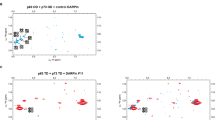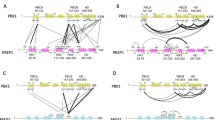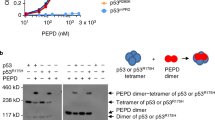Abstract
The function of p53 correlates with its ‘wildtype’ conformation, specifically recognized by antibodies PAb1620 and PAb246, and many cancer-associated mutations cause loss of this conformation. The epitopes of these antibodies were identified using hybrid p53 proteins created by a new method. Plasmids carrying homologous genes cut at appropriate sites recombined efficiently when transformed into RecE+ E. coli. PAb1620 and PAb246 recognize mouse but not chicken p53; we created mouse–chicken hybrids of the p53 core domain and tested antibody reactivity. PAb246 binding mapped to residues 201–212, while PAb1620 required both residues 145–157 and 201–212 (human p53 numbering used throughout). An alanine-scan showed that the key residues for PAb246 and PAb1620 are completely distinct: PAb246 recognizes residues 202–204 (Tyr-Pro-Glu) while PAb1620 recognizes residues Arg156, Leu206, Arg209, and Gln/Asn210, the last two residues being essential. Both antibody epitopes are far from the p53 interface with DNA, but near the epitope of the ‘mutant’ conformation antibody PAb240. These epitope locations may help in dissecting the interactions of p53, including those with E6/E6-AP and in its DNA-bound state.
This is a preview of subscription content, access via your institution
Access options
Subscribe to this journal
Receive 50 print issues and online access
$259.00 per year
only $5.18 per issue
Buy this article
- Purchase on Springer Link
- Instant access to full article PDF
Prices may be subject to local taxes which are calculated during checkout




Similar content being viewed by others
References
Balagurumoorthy P, Sakamoto H, Lewis MS, Zambrano N, Clore GM, Gronenborn AM, Appella E, Harrington RE . 1995 Proc. Natl. Acad. Sci. USA 92: 8591–8595
Ball RK, Siegl B, Quellhorst S, Brandner G, Braun DG . 1984 EMBO J. 3: 1485–1491
Bullock AN, Henckel J, DeDecker BS, Johnson CM, Nikolova PV, Proctor MR, Lane DP, Fersht AR . 1997 Proc. Natl. Acad. Sci. USA 94: 14338–14342
Cho Y, Gorina S, Jeffrey PD, Pavletich NP . 1994 Science 265: 346–355
Chung CT, Niemela SL, Miller RH . 1989 Proc. Natl. Acad. Sci. USA 86: 2172–2175
Cohen PA, Hupp TR, Lane DP, Daniels DA . 1999 FEBS Lett. 463: 179–184
Cook A, Milner J . 1990 Br. J. Cancer 61: 548–552
Foster BA, Coffey HA, Morin MJ, Rastinejad F . 1999 Science 286: 2507–2510
Gannon JV, Greaves R, Iggo R, Lane DP . 1990 EMBO J. 9: 1595–1602
Gillen JR, Willis DK, Clark AJ . 1981 J. Bacteriol. 145: 521–532
Gorina S, Pavletich NP . 1996 Science 274: 1001–1005
Hainaut P, Hernandez T, Robinson A, Rodriguez-Tome P, Flores T, Hollstein M, Harris CC, Montesano R . 1998 Nucleic Acids Res. 26: 205–213
Halazonetis TD, Davis LJ, Kandil AN . 1993 EMBO J. 12: 1021–1028
Halazonetis TD, Kandil AN . 1993 EMBO J. 12: 5057–5064
Hall AR, Milner J . 1995 Oncogene 10: 561–567
Hansen S, Lane DP, Midgley CA . 1998 J. Mol. Biol. 275: 575–588
Huibregtse JM, Scheffner M, Howley PM . 1991 EMBO J. 10: 4129–4135
Hupp TR, Meek DW, Midgley CA, Lane DP . 1992 Cell 71: 875–886
Kaghad M, Bonnet H, Yang A, Creancier L, Biscan JC, Valent A, Minty A, Chalon P, Lelias JM, Dumont X, Ferrara P, McKeon F, Caput D . 1997 Cell 90: 809–819
Kolodner R, Hall SD, Luisi-DeLuca C . 1994 Mol. Microbiol. 11: 23–30
Kraulis PJ . 1991 J. Applied Crystallog. 24: 946–950
Lane DP, Stephen CW, Midgley CA, Sparks A, Hupp TR, Daniels DA, Greaves R, Reid A, Vojtesek B, Picksley SM . 1996 Oncogene 12: 2461–2466
Legros Y, Lafon C, Soussi T . 1994a Oncogene 9: 2071–2076
Legros Y, Meyer A, Ory K, Soussi T . 1994b Oncogene 9: 3689–3694
Levine AJ . 1997 Cell 88: 323–331
Li X, Coffino P . 1996a J. Virol. 70: 4509–4516
Li X, Coffino P . 1996b J. Biol. Chem. 271: 4447–4451
McLure KG, Lee PW . 1996 Oncogene 13: 1297–1303
Medcalf EA, Milner J . 1993 Oncogene 8: 2847–2851
Merritt EA, Murphy MEP . 1994 Acta Crystallographica Section D 50: 869–873
Milner J, Cook A, Sheldon M . 1987 Oncogene 1: 453–455
Molinari M, Milner J . 1995 Oncogene 10: 1849–1854
Müller-Tiemann BF, Halazonetis TD, Elting JJ . 1998 Proc. Natl. Acad. Sci. USA 95: 6079–6084
Ravera MW, Carcamo J, Brissette R, Alam-Moghe A, Dedova O, Cheng W, Hsiao KC, Klebanov D, Shen H, Tang P, Blume A, Mandecki W . 1998 Oncogene 16: 1993–1999
Scheffner M, Werness BA, Huibregtse JM, Levine AJ, Howley PM . 1990 Cell 63: 1129–1136
Soussi T, May P . 1996 J. Mol. Biol. 260: 623–637
Stephen CW, Lane DP . 1992 J. Mol. Biol. 225: 577–583
Stürzbecher H-W, Brain R, Addison C, Rudge K, Remm M, Grimaldi M, Keenan E, Jenkins JR . 1992 Oncogene 7: 1513–1523
Vojtesek B, Dolezalova H, Lauerova L, Svitakova M, Havlis P, Kovarik J, Midgley CA, Lane DP . 1995 Oncogene 10: 389–393
Wade-Evans A, Jenkins JR . 1985 EMBO J. 4: 699–706
Wang PL . 2001 Disease Markers 16
Wang Y, Schwedes JF, Parks D, Mann K, Tegtmeyer P . 1995 Mol. Cell. Biol. 15: 2157–2165
Wolkowicz R, Elkind NB, Ronen D, Rotter V . 1995 Oncogene 10: 1167–1174
Yewdell JW, Gannon JV, Lane DP . 1986 J. Virol. 59: 444–452
Acknowledgements
We thank Alex Bullock, Penka Nikolova, and Alan Fersht for purified human p53 core domain protein, DNA, and MAbs; and Carol Midgley, Sylvain Arnould, and Penka Nikolova for critical reading of the manuscript. PL Wang was supported by a Hitchings-Elion fellowship from the Burroughs-Wellcome Fund and by the Medical Research Council.
Author information
Authors and Affiliations
Rights and permissions
About this article
Cite this article
Wang, P., Sait, F. & Winter, G. The ‘wildtype’ conformation of p53: epitope mapping using hybrid proteins. Oncogene 20, 2318–2324 (2001). https://doi.org/10.1038/sj.onc.1204316
Received:
Revised:
Accepted:
Issue Date:
DOI: https://doi.org/10.1038/sj.onc.1204316
Keywords
This article is cited by
-
Loss of peptidase D binding restores the tumor suppressor functions of oncogenic p53 mutants
Communications Biology (2021)
-
Characterization of a new mouse p53 variant: loss-of-function and gain-of-function
Journal of Biomedical Science (2014)
-
The new platinum(IV) derivative LA-12 shows stronger inhibitory effect on Hsp90 function compared to cisplatin
Molecular Cancer (2010)
-
Chaperone-dependent stabilization and degradation of p53 mutants
Oncogene (2008)
-
Structure–function–rescue: the diverse nature of common p53 cancer mutants
Oncogene (2007)



